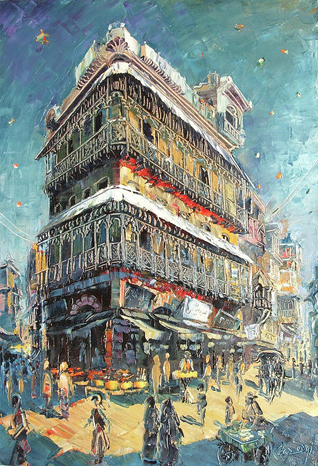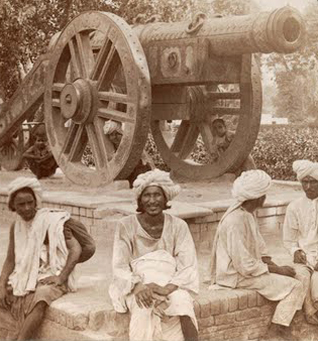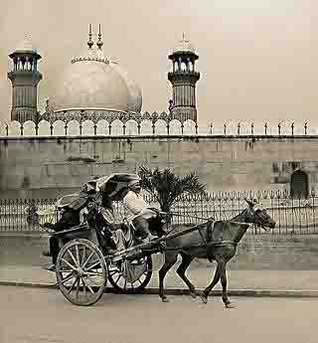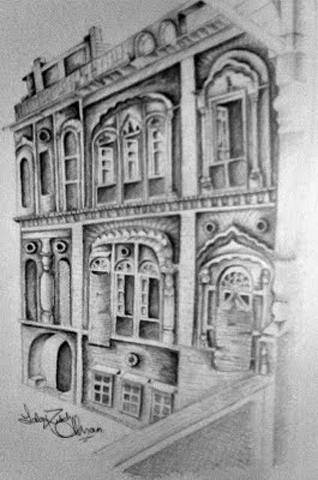Partition
A Tale of Three Cities:
Lahore, Amritsar & Ferozepur
by HARJAP SINGH AUJLA
The Majha region, comprising the old districts of Lahore, Amritsar and Gurdaspur, was also called central Punjab in the pre-Partition days of a united Punjab.
It is bounded on the East by the River Beas, on the West by the River Ravi and on the South by the River Sutlej.
The city of Ferozepore does not form a part of the Majha region. It is about five miles outside the Majha region. Ambala, Ludhiana and Ferozepore were the first three cities of Punjab which came under the complete domination of the British during the first half of the 19th century.
But after the annexation of Punjab by the British - Maharaja Ranjit Singh ruled Punjab until 1849 - the largest and the most significant cities of the region, vis-a-vis Lahore and Amritsar, also came under British rule.
1850 onwards, the colonial British rulers decided to impart a European touch to their favourite cities in Punjab. Lahore had old Mughal and Sikh administrative buildings, which included the famous Lahore Fort, where Maharaja Ranjit Singh had his palace and held court.
The British decided to develop Lahore as an educational hub as well. Government College, Lahore, and the sprawling campus of Panjab University were part of the British plan to make this city a model of the British educational system. The Punjab High Court building and the Punjab Assembly House were built to house the highest judicial and the legislative complexes of the then province of Punjab in Lahore.
The Fourth Sikh Master, Guru Ramdas, had already established a commercial hub 35 miles to the east of Lahore in the city of Amritsar during the 16th century. The British colonial rulers were, by nature, very shrewd businessmen, too. The urban agglomeration of Amritsar came handy to them for further development as a wholesale trade and commercial hub. They encouraged the development of textile manufacturing, both woollen and cotton, in Amritsar. Thus Amritsar became a cash cow for the colonial rulers. After Lahore, Amritsar was developed as the second educational and cultural centre. When the famous Khalsa College was established in Amritsar, its first few principals were renowned British educationists.
Prior to 1849, Ludhiana and Ferozepore served as the eyes of the British, from where they could gather intelligence on the goings on in the "Lahore Darbar" - the heart of the Sikh Kingdom.
Ferozepore was also a base from where the British-Indian forces captured Lahore and their love for this city never diminished. Lahore and Amritsar were heavily congested cities even in 1850. The senior British officers preferred to live in Ferozepore. So they built huge bungalows amid sprawling lawns spread over acres of land in the cantonment area of Ferozepore.
Kasur was the nearest town of Lahore district across the Sutlej from Ferozepore. After 1850, Kasur and Ferozepore experienced a lot of cultural, business and linguistic interaction. Kasur used to get its supplies from Ferozepore, rather than from the comparatively far away Lahore. The rail and road bridges over the Sutlej brought the city of Ferozepore and the town of Kasur very close to each other.
In order to facilitate trade and human interaction among the cities of Ferozepore, Lahore and Amritsar, the British gave priority to building a railway line from Ferozepore to Kasur and Lahore. They built another railway line via Kasur to Amritsar. Before 1947, even Ferozepore’s road links with Lahore and Amritsar were via Kasur.
In the second half of the 19th century, Ferozepore, Lahore and Amritsar started developing into one composite cultural triangle. The barriers of spoken dialects started breaking over a period of time, and cultural affinities developed like never before. This process still continues through the cross-border radio and TV.
In 1947, the large Province of Punjab was bifurcated into Sikh and Hindu dominated East Punjab and Muslim-majority West Punjab. Geographically, more than 60 per cent of the total area of the province was allocated to West Punjab (Pakistan) and less than 40 per cent area remained in India. Both Ferozepore and Amritsar received the share of the Indian Punjab.
But the road and the railway links between Amritsar and Ferozepore got snapped, because Kasur fell into the share of Pakistan. Nearly 65 years after Independence, both Ferozepore and Amritsar are still wanting and in the need of the restoration of the shortest rail and road links.
India’s Independence in 1947 came with an unfortunate exchange of population also. The entire Sikh and Hindu population of nine million in the Western districts of Punjab was brutally made to move to East Punjab. The same brutality happened to most of the Muslims living in Eastern Punjab, too.
The flood of displaced Sikhs and Hindus was borne by the cities of Ferozepore and Amritsar. Most of the displaced Sikhs and Hindus hailing from Sialkot district crossed over to Gurdaspur, Kapurthala and Hoshiarpur, via Amritsar or Dera Baba Nanak. The refugees from Lahore tehsil took the Grand Trunk Road route between Lahore and Amritsar.
But the mostly rural Sikh and Hindu refugees from Kasur and Chunian tehsils of Lahore district took the Kasur-Ferozepore route to cross over into the Indian Punjab.
The urban population of Lahore came first to Amritsar, but soon was dispersed to far off places like New Delhi, Bombay, Lucknow and Kanpur. The rural population of Lahore district was allotted agricultural land on priority in all sub-divisions of Amritsar distrct, including Ajnala, Amritsar, Patti and Tarntaran. Some overflow of refugees from rural Lahore was rehabilitated in Kapurthala and Sultanpur Lodhi tehsils of Kapurthala district.
The majority of rural people of Lahore of Kasur and Chunian tehsils had mostly crossed over into the Ferozepore district and they were allotted land in all the sub-divisions of Ferozepore, including Zira, Ferozepore, Muktsar, Jalalabad, Fazilka and Moga. The post-Partition rehabilitation policy adopted by both rehabilitation commissions, Tarlok Singh and M. S. Randhawa, kept the rural people of Lahore mostly in Amritsar and Ferozepore districts.
The geographical proximity of Lahore, Amritsar and Ferozepore to each other and the post-Independence rehabilitation policy has kept these districts culturally linked, although, geographically Ferozepore city falls within the Malwa region of East Punjab.
The radio and TV transmitters of Lahore and Amritsar are seen and heard quite loud and clear in Ferozepore, and that still is keeping the tri-city area closely knitted together.
[Courtesy: Tribune. Edited for sikhchic.com]
February 26, 2012
Conversation about this article
1: Tarlochan Singh Sian (Khanna, Punjab), February 26, 2012, 9:08 AM.
Thanks for this beautiful article. I found it most interesting.
2: Ramneek Kaur (India), February 26, 2012, 9:25 AM.
A well-written and informative article! However, just a minor correction: maybe this was just a typo. In paragraph 6 above, where the author refers to the university in Lahore, I think he is referring to Punjab University instead of Panjab University (which was set up in post-partition India).
3: Baldev Singh (Bradford, United Kingdom), February 26, 2012, 12:42 PM.
My father used to tell me that Punjab would have been greater than California under the Sikhs! Partition, 1984, desi machinations ... and our own uncouth and ignorant leaders, all have proved that, together, any dream can quickly be turned into a nightmare!
4: Harinder (Uttar Pradesh, India), February 26, 2012, 4:06 PM.
The Punjabi People Exodus:- Momentum I was given by Babur in February, 1526. Momentum II in 1947. For our family the route has been - 1947: Sargodha to Amritsar; 1970: Amritsar to Delhi; 1984: Delhi to Australia. Next stop? Mars? New universe? The next momentum ... spirit of adventure and exploration. Punjabis always on the move!
5: Anita (London, United Kingdom), July 30, 2015, 7:12 PM.
Learned of my father's fascinating early childhood in Ferozepur from 1946-1947, and how the family survived the tensions leading up to the Partition of Punjab. Thanks to the Sikh community, his family was safely protected through this dangerous time. Without them - I don't think I would be here today! Thank you.






